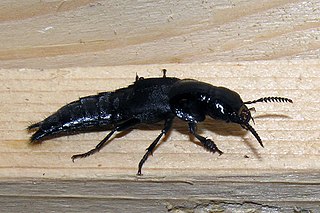
The rove beetles are a family (Staphylinidae) of beetles, primarily distinguished by their short elytra that typically leave more than half of their abdominal segments exposed. With over 66,000 species in thousands of genera, the group is the largest family in the beetle order, and one of the largest families of organisms. It is an ancient group, with fossilized rove beetles known from the Triassic, 200 million years ago, and possibly even earlier if the genus Leehermania proves to be a member of this family. They are an ecologically and morphologically diverse group of beetles, and commonly encountered in terrestrial ecosystems.

Staphylinoidea is a superfamily of beetles. It is a very large and diverse group with worldwide distribution.

Velleius dilatatus, the hornet rove beetle, is a species of rove beetle belonging to the family Staphylinidae. This beetle is commensal with the European hornet, living in its nests.

Xantholinus is a genus of the beetle family Staphylinidae, the rove beetles. They can be found throughout the world. Most are native to the Palearctic realm, and some have been introduced to North America.

Staphylininae are a subfamily of rove beetles. They contain the typical rove beetles with their long but fairly robust blunt-headed and -tipped bodies and short elytra, as well as some more unusually-shaped lineages.

Creophilus is a genus of beetles of the Staphylinidae family, subfamily Staphylininae. It includes some of the largest rove beetle species, up to 30 mm long. Almost all species live primarily on carrion and feed on maggots, and so are of interest to forensic entomologists estimating the age of a corpse. The European species C. maxillosus was described in the Systema Naturae, and has been widely studied, but some other species in the genus are little known.

Diochus electrus is an extinct species of rove beetle in genus Diochus, the only definitive fossil species in subfamily Staphylininae. The species is known only from the middle Eocene, Lutetian stage Baltic amber found in the Blaue Erde deposits, Baltic region, Northern Europe.

The Oxytelinae are a subfamily of the Staphylinidae, rove beetles. There are about 20 genera and at least 320 described species in Oxytelinae.

Quedius cinctus is a species of large rove beetle in the family Staphylinidae.

Quedius is a genus of large rove beetles in the family Staphylinidae. There are about 800 described species in Quedius.

Staphylinini is a tribe of large rove beetles in the family Staphylinidae. There are at least 20 genera and 120 described species in Staphylinini.

Gyrohypnus is a genus of beetles belonging to the family Staphylinidae.
Achenium is a genus of beetle belonging to the family Staphylinidae.
Anthobium is a genus of beetles belonging to the family Staphylinidae.
Autalia is a genus of beetles belonging to the family Staphylinidae.
Bolitobius is a genus of beetles belonging to the family Staphylinidae.
Cypha is a genus of beetles belonging to the family Staphylinidae.
Dianous is a genus of beetles belonging to the family Staphylinidae.
Dinarda is a genus of beetles belonging to the family Staphylinidae.
Diochini is a tribe of rove beetles in the family Staphylinidae. There are at least 2 genera and 84 described species in Diochini.











